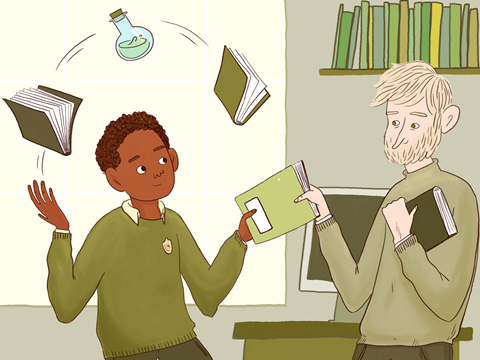Structuring tasks can reduce information overload and increase learning
Cognitive load is a measure of how much students have to think about during a lesson. Too much information, too many distractions, too many novel ideas, and the student can become overloaded. When working memory is overloaded, progress is ineffective and learning stalls.
Cognitive load in the classroom
Paying attention to cognitive load in the classroom includes such things as, when presenting diagrams, consider overlaying the annotations on the image rather than having a separate key. This helps reduce the ‘split attention’ effect, which can add to working memory load. You can use these ideas during practical work, as demonstrated by integrated instructions.

Breaking down complexity
When you set a complex task for your students, consider breaking it down into simpler tasks. For example, consider evaluating two different polymers for making pipes. You might present students with a table of information including cost, strength, polymer chain-length and melting point. On their own, students would need to analyse each piece of data in turn, draw comparisons and link to relevant chemical concepts. However, you could assign each characteristic to a different member of a small group. Individual students then have the simpler task of analysing one area of data and using it to form an argument. They can then feed back to the group, and collaborate on the full evaluation. The larger task has now been broken down into smaller, more manageable tasks.
7 simple rules to boost science teaching
Click to expand and explore the rules
Build on the ideas that pupils bring to lessons
Help pupils direct their own learning
Use models to support understanding
Support pupils to retain and retrieve knowledge
- Pay attention to cognitive load—structure tasks to limit the amount of new information pupils need to process
- Revisit knowledge after a gap to help pupils retain it in their long-term memory
- Provide opportunities for pupils to retrieve the knowledge that they have previously learnt
- Encourage pupils to elaborate on what they have learnt
Use practical work purposefully and as part of a learning sequence
Develop scientific vocabulary and support pupils to read and write about science
Use structured feedback to move on pupils’ thinking
Maths in chemistry
Calculations in chemistry are a perennial problem for many students, despite the mathematical operations themselves generally being quite simple. While areas like BIDMAS and proportions have usually been encountered previously in maths, many students struggle to apply them to chemical contexts. Identifying the relevant maths embedded within a chemistry question adds a layer of complexity to problems, increasing cognitive load.
You can help your students by modelling your thinking. Talk through worked examples on the board. Identify the key information in questions, show how you locate it, and explain what you intend to do with it. Even the medium that these worked examples are presented on can have an effect. For example, a visualiser projection of you working on a copy of the students’ worksheet can help them engage with the problems more easily than using PowerPoint or an interactive whiteboard.
Once you have provided some explicit worked examples, your students will need plenty of practice. A useful method to support them towards competence and confidence is by ‘fading’ the scaffolding. Start with high scaffolding – making each step in a worksheet explicit, and gradually fading down to no scaffolding at all. This way, the students’ working memory is focused on a smaller number of steps in each question.
Coping with titration
A good example is titration calculations. Students have to process concentration and volume data, stoichiometric ratios and unit conversions, as well as identifying anomalous data and calculating averages. If they have to deal with all of this at once in the first question they encounter, it can be a recipe for cognitive overload.
To support your students, plan a series of questions, starting with a fully scaffolded question, showing each step that needs to be carried out. As they progress through the questions, step by step, take the scaffolding away.
Download an example worksheet (as MS Word or pdf) demonstrating this technique, which is equally applicable for other calculation-heavy areas of chemistry, such as reacting masses and bond enthalpies.
Conclusion
When it comes to any new activity, learning is most effective when we can focus on constituent aspects separately, before putting them together. Just as we wouldn’t expect a beginner driver to cope with motorway driving at rush hour, we shouldn’t expect students to cope with complex areas of chemistry without scaffolding. Identify the key knowledge and skills, demonstrate these and allow them to practise them; scaffold and support your students towards competence and confidence.
This article is part of the series 7 simple rules for science teaching, developed in response to the EEF’s Improving secondary science guidance. It supports rule 4a, Pay attention to cognitive load-structure tasks to limit the amount of new information pupils need to process.
Downloads
Worksheet: scaffolding to prevent cognitive overload
Word, Size 55.26 kbWorksheet: scaffolding to prevent cognitive overload
PDF, Size 67.33 kb















1 Reader's comment